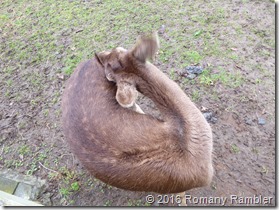Driving through Manakau on SH1 many must have wondered what on earth the orange and green Hughes 500 helicopter was doing there, parked up behind a barbed wire fence. Helicopters such as this paid a very important part in the Deer Story Museum, as we found out on our visit.
Hughes 500 Helicopter outside the museum
It was Robin’s day to arrange an outing for our SLG friends, and he decided to organise a visit this recently opened museum.
From the 1850s Red Deer were released to provide sportsmen with game, as well as Sika, Sambar, Fallow, Wapiti, Rusa and White Tail deer. The deer population exploded and by the 1940s they had colonised the country, damaging the native forests irreversibly and causing erosion. In 1954 deer were declared noxious animals.
The government initiative to this problem was deer culling. Hunters converged in the back country, exploring ridges and valleys, living in draughty huts as they went about the business of shooting deer. The Department of Internal Affairs paid deer cullers a retainer of £7 a week, four shillings per deer tail, and three shillings and sixpence per pig. They spent long periods in the bush with supplies dropped in by fixed-wing aircraft about every four months. The lifestyle was immortalised by famous New Zealand author Barry Crump in his book, A Good Keen Man (1960), based on his experiences as a young government hunter.
Deer cullers hut
Many hunting areas were extremely remote. The helicopter era began when Tim Wallis hired a helicopter and pilot to recover deer from the Wanaka area. Wallis bought his first helicopter in 1965 and learned to fly it. Helicopters were used to fly men into remote areas and bring deer carcasses out. These daring young men put their lives at risk as they aimed their rifles through the open door of the fast moving helicopters, and recovered the meat to sell. Soaring prices for wild venison soon had 20–30 helicopter crews making illegal, but highly profitable, raids into Fiordland National Park. Reports of helicopters being shot at from the ground, arson, sabotage and fist fights soon made headlines. The government sent in air-force helicopters to settle the 'deer wars' situation down.
Dangerous times with bullets flying around
Some later decided that it would be a better idea to farm deer instead of shooting them, and the era of live capture evolved. The first method tried was ‘bulldogging’ – fit young men launched themselves from a helicopter onto a running deer and wrestled it to the ground. With luck, they would tie the animal’s legs, tuck it into a purpose-made canvas bag, and airlift it out on cargo strops to waiting trucks, fixed-wing aircraft, jet boats or capture pens.
Then the net gun, known as the ‘gotcha gun’, was developed about 1978, and fired a nylon net from a helicopter over the fleeing deer. Alpine Helicopters made a net gun with three barrels which could be rapidly reloaded. Later, the net gun was mounted on the skid of the helicopter and fired by the pilot. During this era 201 helicopters crashed killing a total of 49 people while endeavouring to shoot or catch deer.
Net gun in action
From these early beginnings, deer farming is now well and truly established. Each lucky stags gets to mate with 50 hinds, we were told, and mating takes place in Autumn. Venison is exported to Germany, Belgium, the Netherlands along with Scandinavia and North America. Deer velvet and tails, pizzels, testicles and sinews find a ready market in Chinese medicine as the deer is a symbol of luck, health and longevity.
We saw two hand reared fawns outside, and they readily came up to the fence looking for food. I was amazed when one of them demonstrated how easy it was to contort it’s body to have a little nibble of it’s hind quarters!
Hand reared fawn
We had a very interesting visit to the Deer Story Museum indeed - the brainchild of Sanson deer farmer Percy Burlace. “I was one of the idiots who used to do the net shooting and jump out of helicopters in the early days, and survived to tell the story,” he told us.
Percy Burlace, of the Deer Story Museum








1 comment:
Wow, did not know that. Very interesting Jenny.
Post a Comment